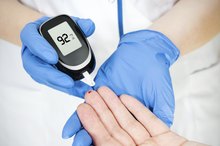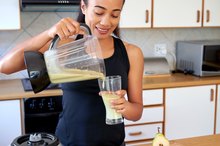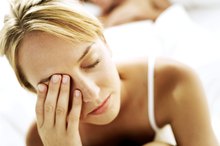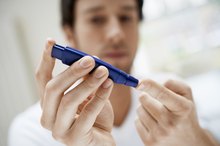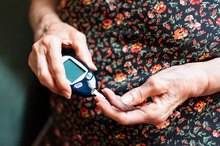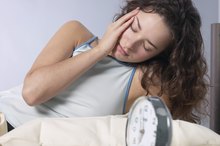Low Blood Sugar in the Morning
Diabetes is characterized by the body's inability to produce insulin or to use it effectively to control blood sugar levels. High blood sugar levels can damage various body systems. Low blood sugar, however, can cause more immediate problems and needs to be corrected to prevent serious complications such as seizures, unconsciousness and death. The key to treating low morning blood sugar is awareness of symptoms, causes and preventative measures.
Symptoms
Low morning blood sugar can be characterized by waking up with a headache in the middle of the night or early morning, pajamas damp from perspiration and general nausea and shakiness. You may look very pale and feel very angry or confused. Your lips may tingle or feel ringed with a buzzing sensation. You may be extra hungry or feel as if you are about to pass out when you stand up.
- Low morning blood sugar can be characterized by waking up with a headache in the middle of the night or early morning, pajamas damp from perspiration and general nausea and shakiness.
- You may look very pale and feel very angry or confused.
Treatment
Low Blood Sugar in Non-Diabetics
Learn More
The American Diabetes Association recommends treating a low morning blood sugar level with 15 g of carbohydrate. Orange juice or glucose tablets should resolve the problem. Candy is another option, but the fat in chocolate makes it take longer for the sugar to be absorbed into the bloodstream. Four ounces of soda will also help; however, it cannot be diet soda as it has no carbohydrates in it. Try not to exceed 15 g of carbohydrate because eating more may cause hyperglycemia.
- The American Diabetes Association recommends treating a low morning blood sugar level with 15 g of carbohydrate.
- Try not to exceed 15 g of carbohydrate because eating more may cause hyperglycemia.
Tight Control
Tight diabetic control refers to keeping your blood sugar levels as close to normal as possible at all times to prevent or delay diabetic complications. Before meals, target blood sugar levels should be between 70 and 130 mg/dL and rise to less than 180 mg/dL two hours after starting a meal, according to the American Diabetes Association. Practicing tight diabetic control may produce a low morning blood sugar. A doctor can adjust your medications and diet for you if this happens.
- Tight diabetic control refers to keeping your blood sugar levels as close to normal as possible at all times to prevent or delay diabetic complications.
Monitoring
Good Snack Before Bed for Low Blood Sugar
Learn More
Monitoring blood sugar levels is an important part of controlling diabetes and preventing low morning blood sugar. (Ref 4)Test before you retire for the evening, especially if you have been exercising vigorously during the day, to ensure that your blood sugar level is not already low. Test your blood sugar level upon waking up in the morning before you take your medication. Taking diabetes medication without testing first can cause dangerously low blood sugar levels.
- Monitoring blood sugar levels is an important part of controlling diabetes and preventing low morning blood sugar.
- ( Test your blood sugar level upon waking up in the morning before you take your medication.
Related Articles
References
- American Diabetes Association: Diabetes Basics
- Schönfeld P, Reiser G. Why does brain metabolism not favor burning of fatty acids to provide energy? Reflections on disadvantages of the use of free fatty acids as fuel for brain. J Cereb Blood Flow Metab. 2013;33(10):1493–1499. doi:10.1038/jcbfm.2013.128
- American Diabetes Association. Diabetic Ketoacidosis.
- American College of Emergency Physicians. Diabetic Emergencies.
- American Diabetes Association. Hyperglycemia (High Blood Glucose).
- American Diabetes Association. Hypoglycemia (Low Blood Glucose).
Writer Bio
Mary McNally has been writing and editing for over 13 years, including publications at Cornell University Press, Larson Publications and College Athletic Magazines. McNally also wrote and edited career and computer materials for Stanford University and Ithaca College. She holds a master's degree in career development from John F. Kennedy University and a bachelor's degree from Cornell University in counseling.
